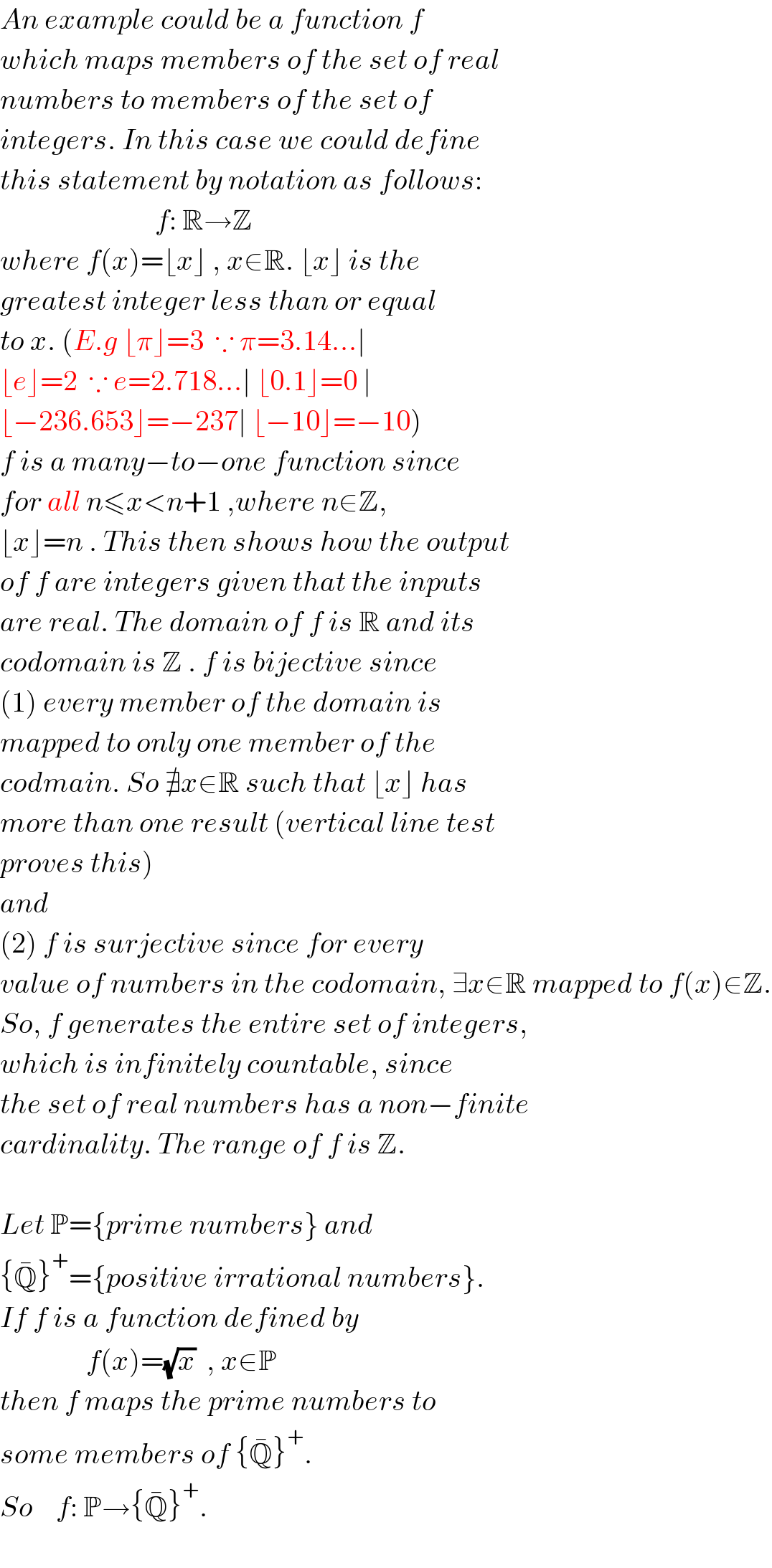
Question Number 2367 by Filup last updated on 18/Nov/15

$$\mathrm{What}\:\mathrm{exactly}\:\mathrm{does}\:{f}:\mathbb{C}\rightarrow\mathbb{C}\:\mathrm{mean}? \\ $$
Answered by RasheedAhmad last updated on 18/Nov/15

$${A}\:{function}\:\:{f}\:\:{whose}\:{domain}\:{and} \\ $$$${range}\:{both}\:{are}\:\mathbb{C}\:\left({set}\:{of}\:{complex}\right. \\ $$$$\left.{numbers}\right) \\ $$
Commented by Filup last updated on 18/Nov/15

$$\mathrm{Oh},\:\mathrm{I}\:\mathrm{see}!\:\mathrm{What}\:\mathrm{other}\:\mathrm{variations}\:\mathrm{are}\:\mathrm{there}? \\ $$$$\mathrm{Could}\:\mathrm{I}\:\mathrm{have}\:\mathrm{some}\:\mathrm{examples}? \\ $$
Commented by RasheedAhmad last updated on 18/Nov/15
![Take an example. If g(x)=(1/x) If x∈N i−e domain of g(x) then g(x)∈(0,1] i−e the range of g(x) We can write g:N→(0,1] Mr. prakash jain,123456, Mr. Yozzi and some others can give more satisfying answer.](Q2375.png)
$${Take}\:{an}\:{example}.\:{If}\: \\ $$$$\:\:\:\:\:\:\:\:\:\:\:\:\:\:\:\:\:\:{g}\left({x}\right)=\frac{\mathrm{1}}{{x}} \\ $$$${If}\:{x}\in\mathbb{N}\:{i}−{e}\:{domain}\:{of}\:{g}\left({x}\right)\:{then} \\ $$$${g}\left({x}\right)\in\left(\mathrm{0},\mathrm{1}\right]\:{i}−{e}\:{the}\:{range}\:{of}\:{g}\left({x}\right) \\ $$$${We}\:{can}\:{write} \\ $$$${g}:\mathbb{N}\rightarrow\left(\mathrm{0},\mathrm{1}\right] \\ $$$${Mr}.\:{prakash}\:{jain},\mathrm{123456},\:{Mr}.\:{Yozzi} \\ $$$${and}\:{some}\:{others}\:{can}\:{give}\:{more} \\ $$$${satisfying}\:{answer}. \\ $$
Commented by 123456 last updated on 18/Nov/15

$${g}\left({z}\right)=\frac{\mathrm{1}}{{z}} \\ $$$$\mathrm{all}\:\mathrm{complex}\:\mathrm{number}\:\mathrm{except}\:\mathrm{0}\:\mathrm{can}\:\mathrm{be}\:\mathrm{pruged} \\ $$$$\mathrm{then}\:\mathrm{the}\:\mathrm{domain}\:\mathrm{is}\:\mathbb{C}/\left\{\mathrm{0}\right\} \\ $$$$\mathrm{the}\:\mathrm{range}\:\mathrm{is}\:\mathrm{all}\:\mathrm{complex}\:\mathrm{except}\:\mathrm{0},\:\mathrm{since} \\ $$$$\mathrm{1}/{z}\rightarrow\mathrm{0},{z}\rightarrow\overset{\sim} {\infty}\:\left(\mathrm{complex}\:\mathrm{infinity}\right) \\ $$$$\mathrm{then}\:\mathrm{it}\:\mathrm{can}\:\mathrm{be}\:\mathrm{give}\:\mathrm{by} \\ $$$${g}:\mathbb{C}/\left\{\mathrm{0}\right\}\rightarrow\mathbb{C}/\left\{\mathrm{0}\right\}\:\mathrm{simple}\:\mathrm{pole}\:\mathrm{at}\:{z}=\mathrm{0} \\ $$$$\mathrm{if}\:\mathrm{we}\:\mathrm{take} \\ $$$${h}\left({z}\right)=\begin{cases}{{g}\left({z}\right)}&{{z}\neq\mathrm{0}}\\{\mathrm{0}}&{{z}=\mathrm{0}}\end{cases}\:\left(\mathrm{removing}\:\mathrm{problem}\:\mathrm{at}\:{z}=\mathrm{0}\right) \\ $$$${h}:\mathbb{C}\rightarrow\mathbb{C} \\ $$$$\mathrm{in}\:\mathrm{general}\:\mathrm{you}\:\mathrm{can}\:\mathrm{take} \\ $$$${g}:\mathrm{A}\rightarrow\mathrm{B}\:\mathrm{where}\:\mathrm{A}\subset\mathbb{C}/\left\{\mathrm{0}\right\}\:\mathrm{is}\:\mathrm{a}\:\mathrm{subset}\:\mathrm{of} \\ $$$$\mathrm{the}\:\mathrm{complex}\:\mathrm{excluding}\:\mathrm{0}\:\left(\mathrm{maximal}\:\mathrm{domain}\right. \\ $$$$\left.\mathrm{possible}\right)\:\mathrm{and}\:\mathrm{B}\subset\mathbb{C}\:\mathrm{is}\:\mathrm{a}\:\mathrm{subset}\:\mathrm{that} \\ $$$$\mathrm{depends}\:\mathrm{on}\:\mathrm{A} \\ $$
Commented by Yozzi last updated on 18/Nov/15

$${An}\:{example}\:{could}\:{be}\:{a}\:{function}\:{f} \\ $$$${which}\:{maps}\:{members}\:{of}\:{the}\:{set}\:{of}\:{real} \\ $$$${numbers}\:{to}\:{members}\:{of}\:{the}\:{set}\:{of} \\ $$$${integers}.\:{In}\:{this}\:{case}\:{we}\:{could}\:{define} \\ $$$${this}\:{statement}\:{by}\:{notation}\:{as}\:{follows}: \\ $$$$\:\:\:\:\:\:\:\:\:\:\:\:\:\:\:\:\:\:\:\:\:\:\:\:\:\:\:{f}:\:\mathbb{R}\rightarrow\mathbb{Z} \\ $$$${where}\:{f}\left({x}\right)=\lfloor{x}\rfloor\:,\:{x}\in\mathbb{R}.\:\lfloor{x}\rfloor\:{is}\:{the} \\ $$$${greatest}\:{integer}\:{less}\:{than}\:{or}\:{equal} \\ $$$${to}\:{x}.\:\left({E}.{g}\:\lfloor\pi\rfloor=\mathrm{3}\:\:\because\:\pi=\mathrm{3}.\mathrm{14}...\mid\right. \\ $$$$\lfloor{e}\rfloor=\mathrm{2}\:\:\because\:{e}=\mathrm{2}.\mathrm{718}...\mid\:\lfloor\mathrm{0}.\mathrm{1}\rfloor=\mathrm{0}\:\mid \\ $$$$\left.\lfloor−\mathrm{236}.\mathrm{653}\rfloor=−\mathrm{237}\mid\:\lfloor−\mathrm{10}\rfloor=−\mathrm{10}\right)\: \\ $$$${f}\:{is}\:{a}\:{many}−{to}−{one}\:{function}\:{since} \\ $$$${for}\:{all}\:{n}\leqslant{x}<{n}+\mathrm{1}\:,{where}\:{n}\in\mathbb{Z}, \\ $$$$\lfloor{x}\rfloor={n}\:.\:{This}\:{then}\:{shows}\:{how}\:{the}\:{output} \\ $$$${of}\:{f}\:{are}\:{integers}\:{given}\:{that}\:{the}\:{inputs} \\ $$$${are}\:{real}.\:{The}\:{domain}\:{of}\:{f}\:{is}\:\mathbb{R}\:{and}\:{its} \\ $$$${codomain}\:{is}\:\mathbb{Z}\:.\:{f}\:{is}\:{bijective}\:{since}\: \\ $$$$\left(\mathrm{1}\right)\:{every}\:{member}\:{of}\:{the}\:{domain}\:{is} \\ $$$${mapped}\:{to}\:{only}\:{one}\:{member}\:{of}\:{the}\: \\ $$$${codmain}.\:{So}\:\nexists{x}\in\mathbb{R}\:{such}\:{that}\:\lfloor{x}\rfloor\:{has} \\ $$$${more}\:{than}\:{one}\:{result}\:\left({vertical}\:{line}\:{test}\right. \\ $$$$\left.{proves}\:{this}\right) \\ $$$${and} \\ $$$$\left(\mathrm{2}\right)\:{f}\:{is}\:{surjective}\:{since}\:{for}\:{every}\: \\ $$$${value}\:{of}\:{numbers}\:{in}\:{the}\:{codomain},\:\exists{x}\in\mathbb{R}\:{mapped}\:{to}\:{f}\left({x}\right)\in\mathbb{Z}. \\ $$$${So},\:{f}\:{generates}\:{the}\:{entire}\:{set}\:{of}\:{integers}, \\ $$$${which}\:{is}\:{infinitely}\:{countable},\:{since} \\ $$$${the}\:{set}\:{of}\:{real}\:{numbers}\:{has}\:{a}\:{non}−{finite} \\ $$$${cardinality}.\:{The}\:{range}\:{of}\:{f}\:{is}\:\mathbb{Z}. \\ $$$$ \\ $$$${Let}\:\mathbb{P}=\left\{{prime}\:{numbers}\right\}\:{and} \\ $$$$\left\{\bar {\mathbb{Q}}\right\}^{+} =\left\{{positive}\:{irrational}\:{numbers}\right\}. \\ $$$${If}\:{f}\:{is}\:{a}\:{function}\:{defined}\:{by} \\ $$$$\:\:\:\:\:\:\:\:\:\:\:\:\:\:\:{f}\left({x}\right)=\sqrt{{x}}\:\:,\:{x}\in\mathbb{P} \\ $$$${then}\:{f}\:{maps}\:{the}\:{prime}\:{numbers}\:{to} \\ $$$${some}\:{members}\:{of}\:\left\{\bar {\mathbb{Q}}\right\}^{+} . \\ $$$${So}\:\:\:\:{f}:\:\mathbb{P}\rightarrow\left\{\bar {\mathbb{Q}}\right\}^{+} . \\ $$$$ \\ $$
Commented by Filup last updated on 18/Nov/15

$$\mathrm{Thank}\:\mathrm{you}\:\mathrm{all}\:\mathrm{so}\:\mathrm{much}!\:\mathrm{I}\:\mathrm{understand}\:\mathrm{now}! \\ $$
